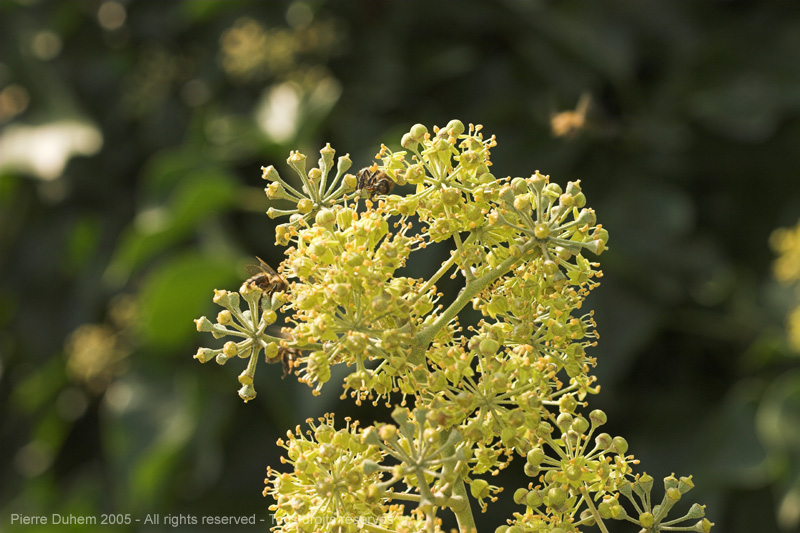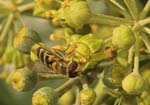

English Ivy

In Montmartre cemetery, two splendid English ivy stands dominate the
main entrance and the old way leading to the upper part.
In Autumn, this is the last place to feed for many insects,
just before the cold season...
Click below on the thumbnails to display a bigger picture.
Click again on the picture to come back.
Honeybees (Apis mellifera) are as always steady visitors.
And so are Ivy Bees (Colletes hederae). The life cycle of this species follows the cycle of the English Ivy. Female Ivy Bees only visit those ivy flowers.
Therefore, they have to work hard as long as the flowers give pollen and nectar.
Male Ivy Bees also gather pollen and nectar, but they happen to visit other plants. In such a case, they are more difficult to identify. Here, look at the heavier antennae.
Other Hymenopterae are also present, like those Bumblebees.
Unlike Honeybees and Ivy Bees, Bumblebees have a strange behavior on ivy. They seem to be dull, sluggish, almost drunk.
Ivy flowers exhale a strong odor and the active principle of ivy, named hederin, is sometimes used in the human medicine. It seems to have a sedative effect on some insects.
This calmant effect was so strong on this Carpenter Bee (Xylocopa sp.) that, after feeding on a flower, it could not fly away normally and had to stay a few moments on a Pelargonium to recover.
Other insect families seem to also appreciate this strong nectar, like this Red Admiral (Vanessa atalanta) which lets the photograph come near it without flying away...
Likewise for this Painted Lady (Vanessa cardui)...
This little Geometridae (Idaea seriata) seems to appreciate good catering, like bigger ones.
Coming back to Aculeates, here is an European Hornet (Vespa crabro), which is rare on this ivy stand, but frequents each year another one in the Parc Monceau.
And some common wasps (Vespula vulgaris), less numerous this year...
Ladybeetles never miss such a rendez-vous, like Adalia bipunctata, with a red form and a black form...
After two spots, here are seven spots (Coccinella septempunctata).
And now the Asian multicolor Ladybeetle (Harmonia axyridis), as dangerous for aphids as for other ladybeetles.
How could those fascinating ivy flowers leave flies insensible...
Here comes an Eristalis sp., then Eristalis tenax, to be identified by two hair stripes on the eyes.
And now a Myathropa florea takes the time to spend a penny.
Syrphus ribesii is always splendid and really elegant.
Let's finish with this Syritta pipiens, to be identified because of its popeye-like back thighs.
This little walk would not be complete without two pictures from last year, showing how the ivy fruits mature and become those black berries, which blackbirds are fond of.
Most pictures taken in Autumn 2005.
All rights reserved.
Last update: February 2023
Questions and comments are welcome.
Back to the Feature Gallery





































































